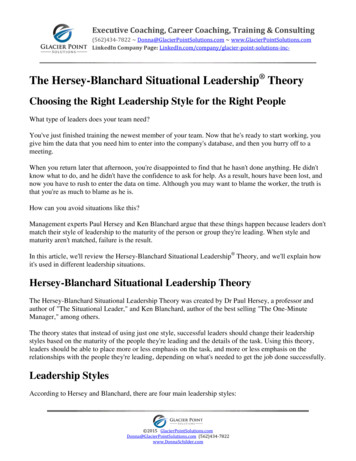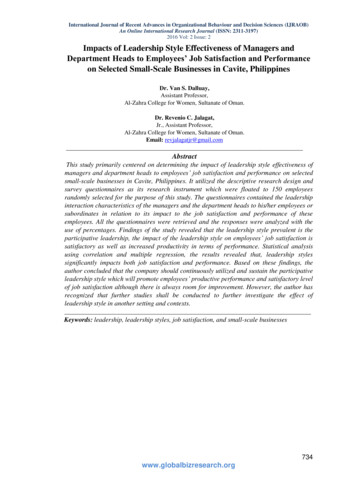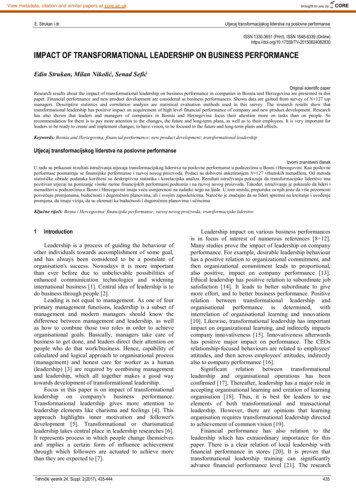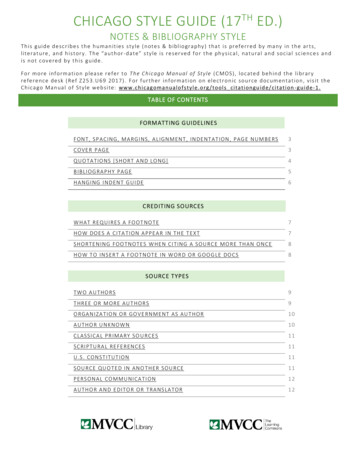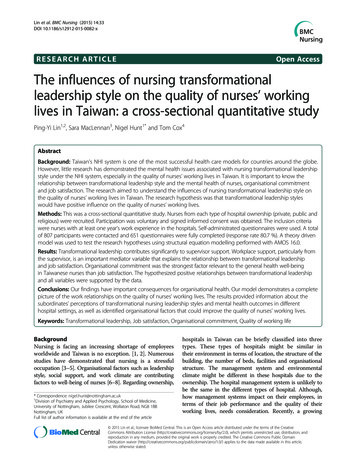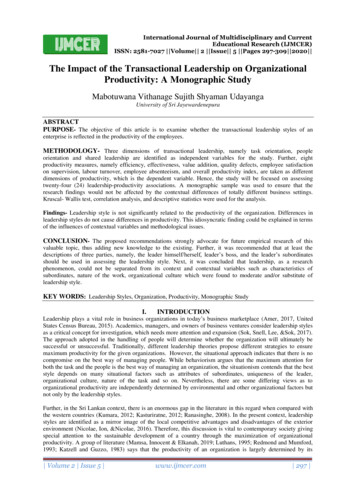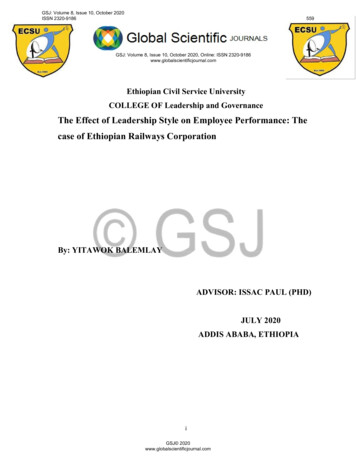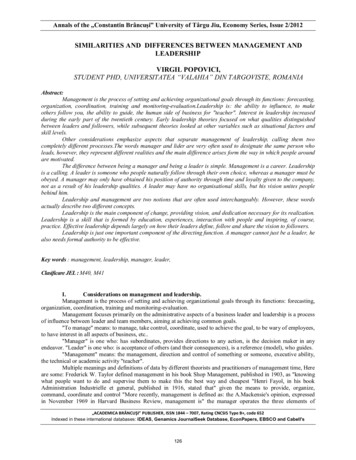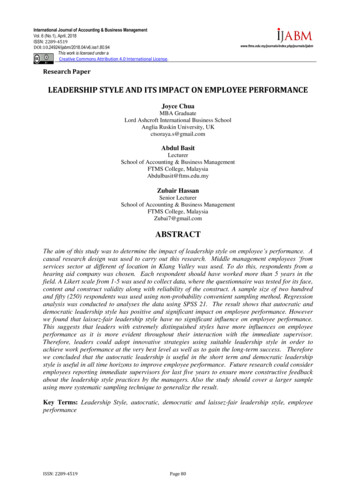
Transcription
International Journal of Accounting & Business ManagementVol. 6 (No.1), April, 2018ISSN: his work is licensed under aCreative Commons Attribution 4.0 International s/ijabmResearch PaperLEADERSHIP STYLE AND ITS IMPACT ON EMPLOYEE PERFORMANCEJoyce ChuaMBA GraduateLord Ashcroft International Business SchoolAnglia Ruskin University, UKctsoraya.s@gmail.comAbdul BasitLecturerSchool of Accounting & Business ManagementFTMS College, MalaysiaAbdulbasit@ftms.edu.myZubair HassanSenior LecturerSchool of Accounting & Business ManagementFTMS College, MalaysiaZubai7@gmail.comABSTRACTThe aim of this study was to determine the impact of leadership style on employee’s performance. Acausal research design was used to carry out this research. Middle management employees ‘fromservices sector at different of location in Klang Valley was used. To do this, respondents from ahearing aid company was chosen. Each respondent should have worked more than 5 years in thefield. A Likert scale from 1-5 was used to collect data, where the questionnaire was tested for its face,content and construct validity along with reliability of the construct. A sample size of two hundredand fifty (250) respondents was used using non-probability convenient sampling method. Regressionanalysis was conducted to analyses the data using SPSS 21. The result shows that autocratic anddemocratic leadership style has positive and significant impact on employee performance. Howeverwe found that laissez-fair leadership style have no significant influence on employee performance.This suggests that leaders with extremely distinguished styles have more influences on employeeperformance as it is more evident throughout their interaction with the immediate supervisor.Therefore, leaders could adopt innovative strategies using suitable leadership style in order toachieve work performance at the very best level as well as to gain the long-term success. Thereforewe concluded that the autocratic leadership is useful in the short term and democratic leadershipstyle is useful in all time horizons to improve employee performance. Future research could consideremployees reporting immediate supervisors for last five years to ensure more constructive feedbackabout the leadership style practices by the managers. Also the study should cover a larger sampleusing more systematic sampling technique to generalize the result.Key Terms: Leadership Style, autocratic, democratic and laissez-fair leadership style, employeeperformanceISSN: 2289-4519Page 80
1.INTRODUCTIONThis study focus on examining the impact of leadership styles on employeeperformance. The historical perspective of leadership indicated that recently leadership isused as an effective management approach to manage large size organizations (Iqbal, Anwar& Haidar , 2015). The gradual replacement of personnel administration with human resourcemanagement results integration of leadership styles into effective employee management orperformance (Iqbal et al, 2015). This demands leaders to adapt themselves to varioussituation when demand arise to ensure there is effective leadership (Heresy & Blanchard,1988). Different leadership styles were used based on the amount of direction, decisionmaking power and empowerment (Iqbal et al, 2015). When it comes to administration theleadership , situation and performance of employees are loosely connected and let to hang ontheir own (Iqbal et al, 2015). This has caused poor employee performance due to the lack ofdirection and strategic leadership in managing routine work.Many researches, in the past examined the performance and factors affectingemployee performance. One of the dominant key factor that have been discussed in the pastresearches were leadership such as participative, autocratic, and democratic (Iqbal et al,2015). Similarly many researches were done to examine the performance and how it wasaffected by various leadership styles. Most of the studies were highly lacking the datacollected on Malaysian context, especially on employees performance and leadership style incommercial service such as ear hearing service providers. The three leadership style wasconsidered as dominant in the past literature, although no research was conducted to examinethese styles in the hearing aid sector’s working managers to examine at what extent the styleof leadership affected its employees. (Iqbal et al , 2015).)To achieve the aim of this study, the following objectives are formulatedTo examine the impact of autocratic leadership Style on Employee PerformancesTo examine the impact of democratic leadership Style on Employee PerformancesTo examine the impact of laisses-fair leadership style on Employee PerformancesThe rest of the paper is organised with four section. The next section will focus on literaturereview, followed by research methods and data collection procedures, data analysis anddiscussions and conclusion & recommendations.2. LITERATURE REVIEWLeadership is the most cogitating and investigate at organizational variable, the leaderhas a potential impact on employee performance (Cummings & Schwab, 1973). The conceptof leadership is originally developed in folk psychology to explain the factor of leadershipstyle impact on employee (Jaskaran & Sri-Guru, 2014). Leadership is the process by whicha person exerts influence over people and inspires, motivates, and directs their activities tohelp achieve group or organizational goals (Jones & George, 2004). Leadership is essentiallya process in which one individual or sometimes a small group of individuals influences theefforts of others towards the achievement of goals in a given set of circumstances (Cole,2005). Leadership style is a pattern of behaviours which engaged in by leader when dealingwith employee. Lewin, Leppit, and White (1939) acknowledged three leadership styles suchas autocratic, democratic and Laissez-Faire. Vigoda-Gadot (2007) argued that , every leaderin their organization and operations practices particular leadership style where such styles isreferred as a set of the behaviour patterns, leadership frequently occurs during the constantorganizational work and others knows leaders by leadership. The manager of theorganization is in very cooperation with the employee, the leadership style of these managersISSN: 2289-4519Page 81
has a significant impact on employee self-confidence. Consequently it was found that theemployee self-confidence has a positive impact on performance (Shirzad & Zanganeh, 2011).Jago (1982) argued that the good leaders are made, but not born. If the person has the desireand determination, he/she can become an effective leader (Jago, 1982). Good leadersdevelop through a never-ending process of self-study, education, training, and experience(Jago, 1982). The other popular definitions of leadership stated that it is more about anindividual who influences a group of people to achieve a common goal (Northouse, 2017).According to Zeitchik (2012), leadership about inspiring others to trail the vision until itbecomes a shared effort to achieve the vision. Cole (2005) defined leadership as a dynamicprocess whereby one man influences others to contribute voluntarily to the realization andachievement of the goals and objectives.Leadership style is the most dominant factors that impact employees’ attitudes andbehaviours including organizational commitment. Leadership can be defined as the capacityto impact a group of employees’ decision, behaviour, recognition of the goal, and work withconfidence and zeal (Adair, 2002). Leader is required to develop the future vision, tomotivate the organizational members, and to achieve the visions and to improve theperformance (Adair, 2002). According to Adair (2002) leadership is the ability to encourageothers to seek out and defined objectives enthusiastically. It is the human factor which bindsa group together and to improve their performance and to direct them towards goals(Koudri,1999). Also it was suggested that leadership is to deal and cope with change, focuson the long-term and the big picture, not always keep to save him/herself to take risks, andconcentrating on people and their values, not just only the bottom-line (Koudri, 1999).The main goal of any organization is to enhance the employee’s job performance thatit could survive in this highly competitive environment. Performance is a multidimensionalconstruct and an extremely vital criterion that determines organizational successes or failures(Prasetya & Kato, 2011 July). According to Niranjana and Pattanayak (2005), theperformance of an employee is the result and behavior on a task which can be observed andevaluated. Niranjana and Pattanayak (2005) also argued that employee performance is thecontribution made by an individual in the accomplishment of organizational goals.Employee performance can be simply the result of the patterns of action, and bring it out tosatisfy an objective (Ibrahim, Al Sejini, & Al Qassimi, 2004). According to some researchesemployee performance consists of directly observable actions of an employee, and alsorelated to either mental actions or products, such as the answers and decisions (Ibrahim et al2004). This results in organizational attainment of goals. Ibrahim et al (2004) defined jobperformance as an important activity that provides both the goals and methods to achieve theorganizational goals.Since leadership is one of the key issues that organisation faces and attributes to itssuccess and failures, a vast majority of literature , in the past, have focus on examining theimpact of leadership and its effects on employee performance or organisational performance.The similar significant number of studies also has done over in Malaysia. The table belowshows some of the key researches done on Malaysian context in examining the impact ofleadership and its impact on employee performance.ISSN: 2289-4519Page 82
Table 1: Key studies on leadership in the study contextNoStudent studyTitleDimension/ VariableNasrah, (2012)The relationship between leadership style andLeadership styleemployee performance: A case of federalemployee performance,public sector in Sabahfederal public sector in Sabah.Impact of Leadership Styles on Employeeleadership styles,Adaptability in Call Center: A Perspective ofemployee adaptability,Telecommunication Industry in Malaysiatelecommunication industryLeadership Styles and Employees’ TurnoverLeadership styleIntention: Exploratory Study of Academic StaffEmployees’ turnoverin a Malaysian CollegeTransformation.123Muthuvelooal ship;employees Job satisfaction in public sectortransformational;organizations in Malaysiatransactional;job satisfaction;working condition;working assignment5Arham ( 2014)Leadership and Performance: The Case ofTransformationalleadership,Malaysian Smes In the Services mance,Services SMEs, Malaysia.6Nasiretal(2014)7Longet(2014)alThe Relationship of Leadership Styles andLeadership styles,organizationalorganizational performance,performanceamongIPTAAcademic Leaders in Klang Valley Area,IPTA,MalaysiaAcademic leadersThe Impact of Transformational LeadershipTransformational leadershipStyle on Job SatisfactionFollowersLeadership stylesJob satisfactionRelationship8Ali and TangLeadership Styles, Business Performance JobJob Satisfaction influence(2016 January)Satisfaction, New Leadership Framework,Business performanceMalaysiaFrom the past literature, it is obvious that the dominant three style of leadership areautocratic, democratic, and laisses-faire style of leadership. Therefore these three styles willbe reviewed.Swarup (2013) argued that autocratic leadership style is a classified leadership style.It’s a style of leadership where a manager is the most powerful entity and it is the primarydecision maker (Gordon, 2013). This style of leadership is based on the traditional premisethat leaders are good managers who direct and control their people. Autocratic leadershipstyle should be adapted to the characteristics of the leader, the subordinate, and the nature ofthe situation (Mullins, 2007). Mullins (2007) described autocratic leadership is appropriateISSN: 2289-4519Page 83
to get the best results during crisis. The attention which given by employee to leadership isbased on the assumption that subordinates are more likely to work effectively for managerswho adopt a certain style of leadership (Mullins, 2007). DuBrin, Dalglish and Miller (2006)argued that autocratic leader emphasis and considered as a task oriented, and focus on tasksaccomplishment. The autocratic leader monitors and exercises powers with little trust orconfidence on the followers (DurBrin et al, 2006). Due to this attitude, followers in thesystem fear and mistrust their leader (Jooste & Fourie, 2009). As autocratic leaders areappropriated in a crisis, difficult and complex situations or situation where quick decision arerequired to make, autocratic leaders become more effective (Jooste & Fourie, 2009).Autocratic leadership is demonstrated as a controlling, directing, or coercive leader, whoseldom takes decisions basing on input from their subordinates (Bass, 1990). Similarly, withMcClelland, (1975) autocratic leadership is based on personal dominance and authoritarianbehavior that serves the self-interest of the leader, is self-aggrandizing and exploitative ofothers. The decision is made without any form of consultation and works when there is noneed for input on the decision. They make plans of each milestone and their followers arebound to work or follow the rules (Maxwell, 2015). In short, the autocratic leader has fullcontrol of those around him and believes to have the complete authority to treat them as hewants. This is useful when immediate and quick decision and performance is required.Dawson (2002) stated that the autocratic style may show great results in a short time period.Similarly Koontz et al (1978) argued that autocratic leadership is only useful with, such as“situation of emergency” and “in case where homogenous work force is involved” and wherethe leader is wise, just and has considerable under-standing of the followers.H1: Autocratic Leadership Style has a positive significant impact on employee performanceThe Democratic Leader acts to value inputs and commitment via participation, listeningto both the bad and the good news (Lewin et al, 1939). Smith (1998) asserted that thedemocratic leaders have a good relationship with the employee results the effectiveness willand high employee performance. Anderson (1991) also described that democratic leaders asone who shares decision making with the other members and therefore, democratic leadershipis connected with higher morale. He denied that democratic leadership is associated with lowproductivity and high morale and that authoritarian leadership is associated with highproductivity and low morale. Daft (2014) also argued that democratic leader delegatesauthority to others to encourages to make employee own decisions and mostly relies onsubordinates’ knowledge to complete the task. The group members have a greater to say indecision-making, determination of policy, implementation of systems and procedures(Mullins, 2007). Jooste and Fourie (2009) argued that democratic leadership leads toimprove productivity and job satisfaction. Democratic Leadership style is one of the mosteffective leadership style that leads to higher productivity, better contributions from groupmembers, and increased group morale (Anderson, 1991). Under democratic leadership, thesuperiors allows the subordinates to use their abilities to initiative and make contributions(Anderson, 1991). The leaders also offer support to the subordinates in accomplishing tasks(Igbaekemen &Odivwri, 2015). In this style, managers’ enable employees to makesuggestions and recommendations on major issues and give subordinates full control andresponsibility for those tasks, encourage subordinates to become good leaders and involved inleadership and employee development (Iqbal et al 2015). This style provides confidence toemployees who will help them for meeting deadlines, and departmental goals, to provideefficient team inputs (Iqbal et al, 2015).H2: Democratic Leadership Style has a positive significant impact on employee performanceISSN: 2289-4519Page 84
Leaders who adopt the laissez-faire leadership style exercise little control over thefollowers and let the followers have the freedom to carry out their assigned tasks withoutdirect supervision (Wu & Shiu, 2009). Laissez-faire leadership style, leader never intervenesthe administrative processes and gives limitless freedom to the followers (Karip 1998).Laissez-faire leadership delegate and hands-off to allow group members to make their owndecisions. Wu and Shiu (2009) argued that this type of leaders have little control over theemployee, and enable employees to carry out their assigned tasks without direct supervision.Tarsik, Kassim and Nasharudin (2014) found that laissez-faire leadership style provides littleor no direction and gives employees as much freedom as possible. Base on Cole (2005)laissez-faire leader seldom involved in work. Mullin (2007) also argued that laissez-faireleader consciously makes decision to pass the focus power to subordinates, and allow themhas freedom of action “do as you think”. Jooste and Fourie (2009) design this leadership aspermissive leadership which is based on the premise that followers are ambitious, creative,responsible and accept and achieve the goal together with organization Robbins andDavidhizar (2007) also argued that laissez-fair style is an “abdicates responsibilities, avoidmaking decision”. Akpala (1993) found that laisses-faire leaders make decision very slowlyand there can be a great deal of “buck passing”. As a result, the task may not be undertakenand conditionally become chaotic. Also , some researchers have rejected this results such asGarg and Ramjee (2013) who found that that there is a weak but significant and negativecorrelation between laissez-faire leadership behavior and normative commitment. AlsoChen, Beck, and Amos (2005) found these laissez faire leadership styles created negativeresults. Therefore it indicates that laisses-fair is not an important style that boost themotivation level of workers as compare to other leadership styles (Chaudhry & Javed,2012).However base don the overall studies, it can be hypothesis as follows:H3: Laissez Faire Leadership Style has positive significant impact on employee performance3. RESEARCH DESIGN AND METHODOLOGYSubjectsThe study engaged 216 employees from 6 organizations in Klang Valley, Malaysia.The majority of the respondents were female 138 (63.9%) and male 78 (36.10%). The ethicof the Chinese is 112 respondents constituted 51.90%, Malay 62 respondent constituted28.7%, and 25 Indian respondents constituted 11.6%.It is clear that the 94 (43.5% )respondents are from age group 21-30 years, 70 (32.4%) respondents are from aged groupof 31-40 years old, and 41 to 50 years is about 39 respondents with 18.10%. There 119marriage respondents (55.10%) and 90 people (41.70%) still single. In terms of educationlevel, result show that 97 respondents (36.60%) were bachelor’s degree holder or professionaldegree, and 52 respondents (24.10%) just graduated from some of college. In terms of workexperience, 70 employees (32.40%) has work experience of 5 years, 65 respondents (30.10%) have worked 6 to 10 years, and 27 respondents (12.5%) has worked more than 11 years to15 years. In terms of income , 74 respondents (34.3%) earned a salary of RM2500.00 toRM5000.00. About 73 (33.8%) respondents earned less than RM2500.00. 41 people (19%)earned a salary ranged from RM5000.00 to RM10,000.00 per month.ProceduresThe sample consisted of participants from 6 (six) hearing aid companies. Cochran'stest was used to determine sample size. Sample size of 235 employees was calculated with aconfidence level of 94%. The combined workforce of these companies is approximatelymore than 250 staff. Therefore we distributed 250 copies in the Leadership StyleISSN: 2289-4519Page 85
questionnaires. We received 235 questionnaires from respondents, although 222questionnaires were successfully completed and returned. We only used 216 after omissionof all questionnaires that have multiple responses and other issues in the questionnaires.Random sampling method is also used. Simple random sampling was used andrespondents from each department of each company was selected using a lottery. DataProcessing and data analysis involved data coding and analysis (Gatara, 2010 cited in Suzan,2016). Data analysis was done using quantitative approaches. Descriptive statistics such asmean and percentages were applied in the data analysis. The results were presented usingtables with explanations on all parameters used. The descriptive statistical method wasapplied to analyses quantitative data where data were scored by calculating the percentages,means and standard deviation.Research InstrumentQuestionnaire was designed to gather the data. It consists of three parts: A, B, and C.Part – A: deals with demographic details such as sex, education, age, etc.Part – B: consists of 18 statements to measure the leadership styles of autocratic,democratic, and laisses faire from employee perspectivesPart-C: Five (5) items to measure employee performance such as productivity,punctuality, teamwork, skill improvement and efficiency.By including variables, questionnaire is prepared with five points Likert scalingsystem. Then analysis is made with appropriate statistical tools, in order to prove theobjectives of the study and to test the hypotheses. The scale construction was testing itsnormality and reliability.Normality is assessed using kurtosis and skewness of the data distribution. Inmultivariate analysis (Ryu, 2011), the data normality is ensured if the absolute value is within( 0.1) OR ( . 001). This statistic ranges from -1 to 1. Absolute values above 0.2 indicategreat skewness (Olsson, Gassne, & Hansson, 2009). It is more than Six (6) questions (D1,D2, D6, LF4, EP4, and EP5) which is more than 1 and higher than 2.055) the rest is in anacceptable range and under the suggested value. It is important to note that these are Six (6)questions found to be normal during the pilot testing. Since the greater value of those six (6)questions indicated in Kurtosis’s data set is not considered normal and further reliabilitytesting was conducted.Cronbach’s Alpha is a coefficient of reliability, while the inter-item correlationaddresses the correlation between individual items that should exceed or be greater than 0.3(Hassan & Diallo, 2013). The bench mark value of reliability is 0.7 (Hair, Ringle & Sarstedt,2011). The following results were obtained about the reliability of the research instrument:Table: 2: Reliability oyee PerformanceOverall ScaleISSN: 2289-4519Number of ItemsCronbach’s Alpha(N 216)6665230.6730.9210.6340.8350.808Page 86
4. RESULT AND DISUCSSIONDescriptive esEmployee PerformanceTable: 3: Mean and Standard DeviationNMean2163.122163.642163.372163.76Std. Deviation0.630.820.550.65The table above shows the overall perception of three different leadership behaviourof the managers from employee perspectives. Democratic leadership is considered as themost practiced or displayed behaviour with a mean value of 3.64 (SD 0.682), followed bylaissez-faire with a mean value of 3.37 (SD 0.55) followed by autocratic leadershipbehaviour with a mean value of 3.12 (SD 0.63) indicating the least displayed leadershipbehaviour is autocratic among the managers. Employee performance scored a mean value of3.76 (SD 0.65) suggesting that employee performance was seen as high among theemployees.CorrelationsTable 4: Correlation AnalysisVariablesEmployee yee 7*0.311**0.144*1-0.1300.174*10.446**1*.Correlation is significant at the 0.05 level (2-tailed)**.Correlation is significant at the 0.01 level (2 tailed)Landau and Everitt (2004) listed that the correlation coefficients range which from “1” to “ 1” representing perfect negative and positive correlation. Ringim, et.al. (2012)stated that the general rule of thumb the value should not more than 0.75, similar correlationsof 0.8 or higher are suggested problematic. Any correlation coefficient that is within -1.00 or 1.00 indicates a perfect correlation between the variables (Hair et al, 2011). Therefore,variables that are found with Pearson r value that is closer to “-1.00 or 1.00” will beidentified as perfectly related.The table above suggests that all the leadership styles have a significant and positiverelationship with employee performance. Also laissez-faire style is significant and positivelyassociated with all the other leadership styles.RegressionsTable 5: Model Summary of Employee performanceModelRModel SummarybAdjusted R SquareRSquare10.361a0.1310.118a. Predictors: (Constant), Laissez-faire, Autocratic, Democraticb. Dependent Variable: Employee PerformanceStd. Error of theEstimate0.6142Durbin-Watson1.993The general rules of thumb a good fit is considered to predict a minimum of 60%variation of the dependent variable (Zygnont & Smith, 2014). According to the above tableadjusted R Square is 0.118. Therefore, this model is considered to be a poor fit and it is not agood fit. The Durbin-Watson statistic (Montgomery, Peck, & Vining, 2001) defined betweenISSN: 2289-4519Page 87
0 and 4 for no autocorrelation. The Durbin-Watson is 1.993 which shows no auto correlationbetween selected sample sizes as value falls in a range of 1.5 to 2.5.Table 6: Regression CoefficientsaModelUnstandardized CoefficientsStandardizedCoefficientsBStd. .089-0.048a. Dependent Variable: Employee 000.515According to the table above, autocratic leadership style beta coefficient value is0.191 with a significant value of 0.005 which is lower than 0.05 (Van Vugt & De Cremer,1999). Hence the autocratic leadership style is found to have a positive significant impact onemployee performance. Bass (1990) has noticed that Autocratic leadership mostly acts ascontrolling, directing, or coercive leader, who seldom takes decisions basing on input fromtheir subordinates. Employees fell under pressure reported autocratic supervision on the partof their leaders. However, Dawson (2002) stated that the autocratic style may show greatresults in a short time period. H1: (Accepted)Democratic leadership style has a beta coefficient value of 0.358 with a significantvalue of 0.000 which is lower than 0.01 (Van Vugt & De Cremer, 1999).Hence theDemocratic leadership style is found to have a positive and significant impact on employeeperformance. Lewin et al (1939) found that democratic leadership style in which members ofthe group take a more participative role in the decision-making process, given the opportunityto participate, ideas are exchanged freely, and discussion is encouraged.However, Akpala(1993) argued, democratic leadership is claimed to be earliest amongst all other leadershipstyles. Yet, Iqbal et al (2015) stated that the democratic leadership style is usually considereda benefit for the most companies. This style focuses the management that provides guidanceand help to its team and departments while accepting and receiving the inputs from individualteam members. H2: (Accepted)Laissez Faire leadership style as shown in the table above beta coefficient value is 0.048 with a significant value of 0.515 which is higher than 0.05 (Van Vugt & De Cremer,1999). Hence Laissez Faire leadership style is found to have a Negative insignificant impacton employee performance. According to Ismail, Hussain, and Rashid, (2011) employees whowere allowed to make their own decision would have higher levels of commitment to theorganization. However, Van Vugt et al (2004) argued that Laissez-Faire leader has nocontrol mechanism for group members by giving freedom to employees is perceived as asituation in their favour. H3: (Rejected)5.CONCLUSIONwe have identified that the first and two variables which autocratic and democraticleadership style have a positive and significant impact towards employee’s performanceresulting in these extreme leadership styles can impact on an employee’s performance oneither good or bad ways. However, the Laissez Faire leadership style has a significantnegative impact on employee performance.A strong leadership positive impact an autocratic style, it can take charge of thegroup, assign tasks to different subordinate, and establish solid deadlines for projects to befinished. The subordinates may accept an autocratic style. It allows employees of the groupISSN: 2289-4519Page 88
to pay attention on performing specific tasks without concern about making complexdecisions. This also allows the subordinates to become highly skilled at performing certainduties, which can be beneficial to the group. The autocratic leadership only allow to caterfor the short-term period, as many instances where this leadership style can be problematic.Democratic leadership has been described as the most effective leadership style, but itdoes have some potential downsides. In situations where roles are unclear or time is of theessence, some-time the democratic leadership would lead to communication failures anduncompleted projects. In some cases, group members may not have the necessary knowledgeor expertise to make quality contributions
Leadership is the most cogitating and investigate at organizational variable, the leader has a potential impact on employee performance (Cummings & Schwab, 1973). The concept of leadership is originally developed in folk psychology to explain the factor of leadership style impact on employee (Jaskaran & Sri-Guru, 2014).


